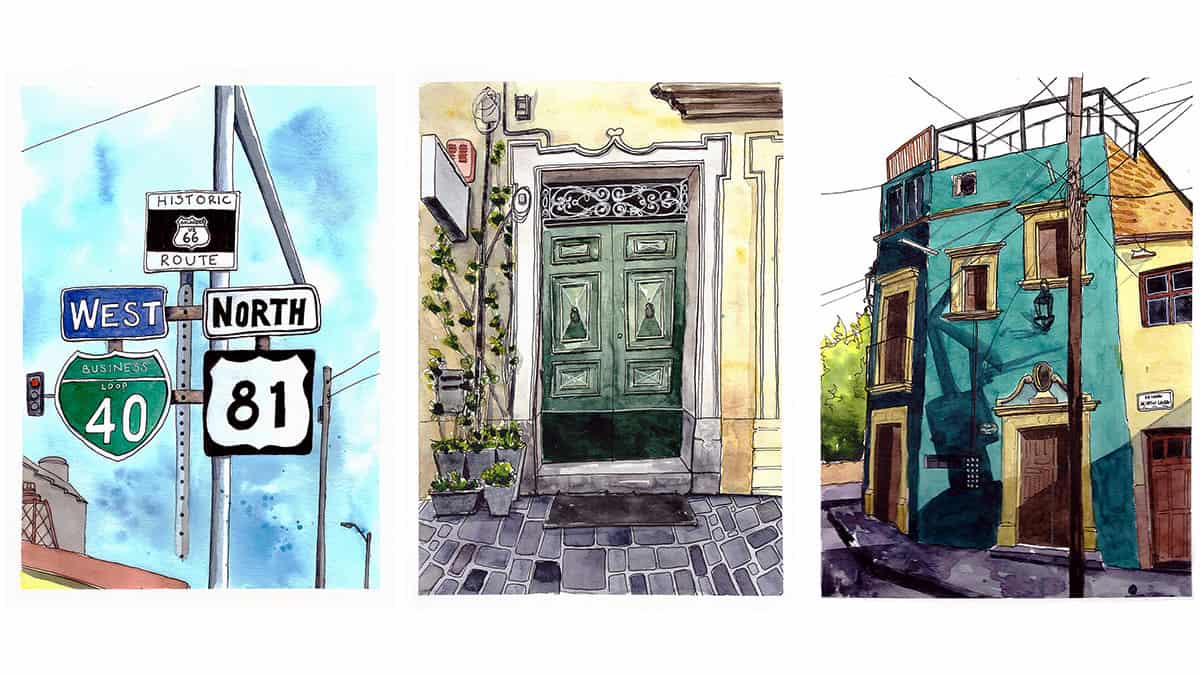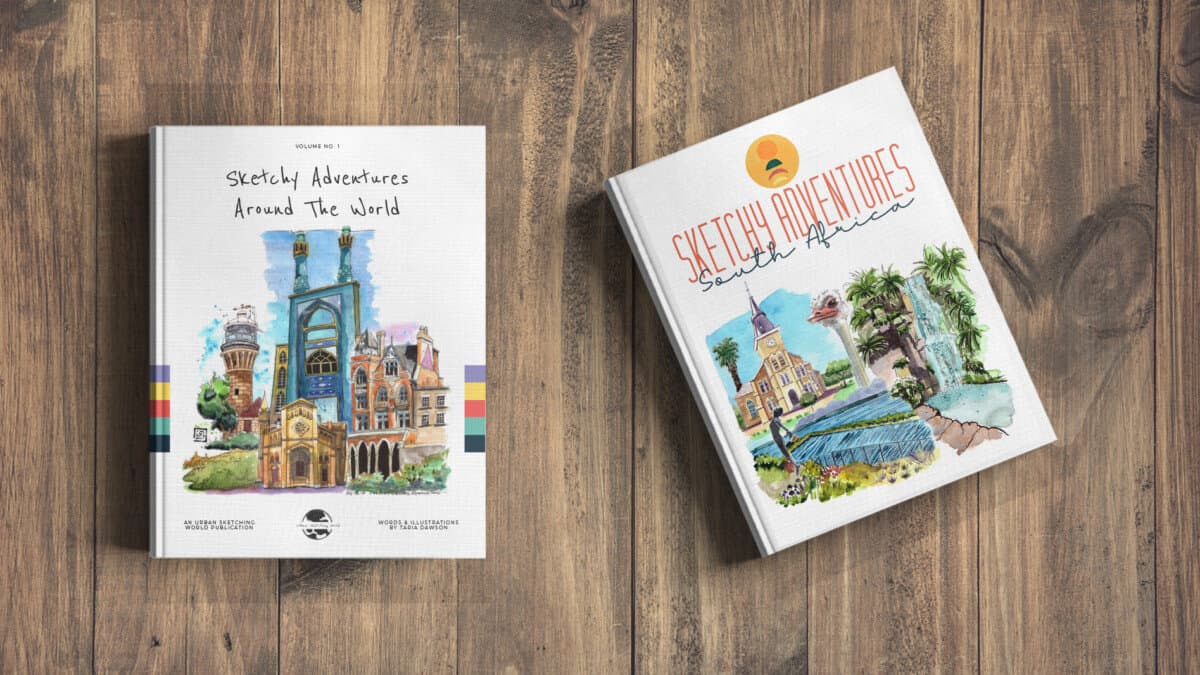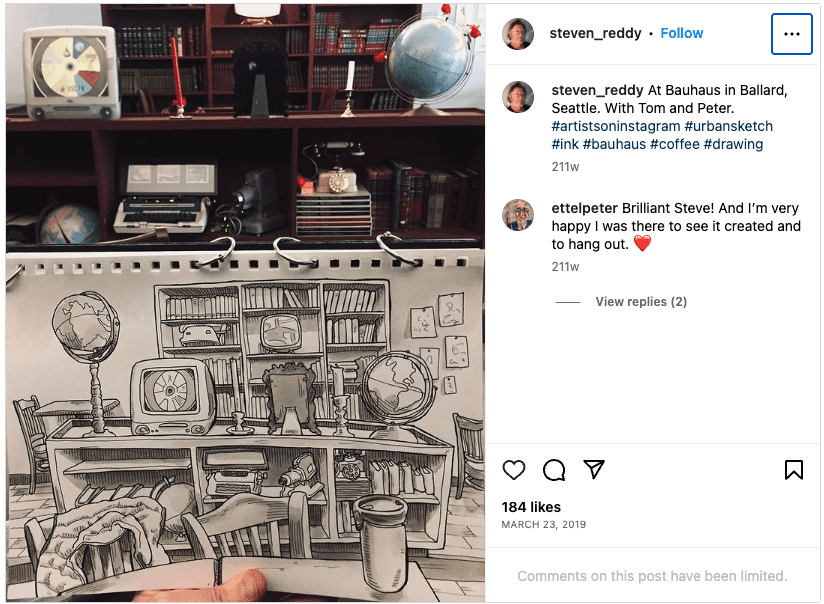In this post, we are going to talk about illustrating your life in a sketchbook or journal, why it is such a worthwhile pursuit and how to go about it.
This post is for anyone, whether you are new to sketching or already have a sketching habit but are looking for other ideas or a new perspective on what you can use your sketchbook for or how you may fit a daily sketch habit into your life.
Journaling, in general, has made a major comeback. Nearly all self-improvement and personal growth gurus talk about journaling as a key technique to reflect and work through things.
The concept of a written journal is nothing new to most of us, however, a journal does not need to be written, you can draw instead (or do both).
What is illustrated journaling?
Have you ever seen any old sketchbooks from adventurers in the 16th and 17th centuries? They would explore new lands, documenting their journey and sketching new people, wildlife and objects they came across in order to bring their discoveries back home and show everyone. There’s a fantastic book by Huw Lewis-Jones (which you can find on Amazon) called ‘Explorers Sketchbooks’ that collects examples from the sketchbooks and journals of intrepid explorers throughout history.
Can you imagine having a collection of sketchbooks, containing a record of your life over the years? Recording all those moments from daily life through to trips of a lifetime, saving ticket stubs and scribbling little notes…things a photograph could never do. Remembering the sights, sounds and smells of exactly where you were when you were sketching. Those kinds of memories are only recalled when looking at a sketch, something that may have taken you 30 minutes, an hour, 2 hours to produce. Think about how far your sketching will have come from when you first started and how you have improved, not only in your technical skills but also in how to catch a moment or a story, frame it and record it for prosperity.
An illustrated journal is basically a diary where you can record anything at all from your life. Instead of just writing, the predominant content is drawn, although many people supplement their drawings with notes, annotations or even some fancy lettering.
You don’t need to be an explorer to keep an illustrated journal. Anyone with a sketchbook and a mark-making tool (such as a pencil or pen) can keep one.
Anyone can keep an illustrated journal
First and foremost your illustrated journal is for you. It’s a safe place for you to be you, to play and experiment, to develop and reflect, to analyse and to dream. If you decide to share some or all of those pages with other people, that that’s totally up to you.
You can draw anything you like in your journal
By the nature of the term ‘journal’, recording your day to day life springs to mind as the obvious thing to start with. But what happens from there…? You still don’t really know what to draw do you? Well, make sure you check out the sections below which will give you loads of ideas.
You may want to make a daily log of your life, maybe you want to keep a food journal, perhaps you want to journal about a specific project you’re working on such a house renovation or school project. You can use your journal to log anything at all.
Do you want to learn how to sketch your own adventures in ink & watercolour?
GET 50% OFF FOR A LIMITED TIME ONLY!!
I will show you my exact sketching process in ink and watercolour. I have travelled around the world in the last 3 years and this is my go-to system of creating beautiful yet quirky illustrations to capture the magic of my discoveries.
We will work through 3 projects, step by step (pictured below), all of which are real-life examples of things I have sketched along my travels. I provide the photo references you can work from.
We will start by choosing a composition, laying in the initial pencil sketch, adding ink lines, layering watercolour and adding the final touches.
This and much more are included in my course, Sketch Your Adventures, click the button under the image to find out more!

Deirdre Love used the format of an illustrated journal to help the work through issues and absorb life lessons while her mother was in the last year of her life.
The benefits of keeping an illustrated journal
Unlike a written journal, illustrated journals tend to be a little more lighthearted, however, some of the deeper mental health benefits (as well as creative ones) remain the same, such as:
- An act of meditation
- Reduces anxiety
- Keeps you present
- Allows self-reflection
- Assists with daily gratitude
- Increases creativity
- Enhances visual storytelling skills
- Helps develop observation skills
- Allows you to process the things that happen in life, the good and the challenging
- Record of your life
- Improve your sketching skills
Why I keep an illustrated journal
My own desire to keep an illustrated journal was sparked by various books by Danny Gregory. I think many people would probably say the same thing as he has been such an inspiration and source of encouragement to sketch every day and to sketch anything at all.
The book that started it all for me was ‘An Illustrated Life: Drawing Inspiration from the Private Sketchbooks of Artists, Illustrators and Designers’ (which I am sure you can get from any book retailer, as well as Amazon). I think I then moved on to ‘An Illustrated Journey: Inspiration From the Private Art Journals of Traveling Artists, Illustrators and Designers’. I was obsessed with these books – it was no wonder I became an urban sketcher and travel illustrator!
I tend to keep an illustrated journal when I travel, it makes the most sense to me as I am generally doing and seeing new and exciting things each day. However, there are plenty of sketchers who keep an illustrated journal of their day to day life. Liz Steel sketches her cup of tea every day…admittedly it’s usually in a very fancy teacup!
My first ‘serious attempt’ at keeping an illustrated journal came when I set off for a solo backpacking trip to Mexico and Central America. As a leaving gift, my work colleagues bought me a beautiful handmade sketchbook, the cover was wrapped with a map of those areas, in which to record my adventures.
When I say ‘serious attempt’, I simply mean a commitment to sketch each day and record my journey consistently. From that moment I was hooked and I have been keeping a journal of my travels ever since.
Check out my ebooks with hundreds of ink & watercolour travel sketches from all over the world. Get some inspiration for your next trip…

If you want to check out that first ‘serious attempt’ at an illustrated travel journal, you can check out my flip through video below!
An illustrated journal can take any form you want, the possibilities are endless, but I believe the point is to (a) form a daily (or at least consistent) sketching habit and (b) to record your life…whether its an exciting trip across the world or a sketch of your living room, anything and everything can be sketched!
Examples of Illustrated Journals
Danny Gregory
As mentioned, Danny Gregory has been a huge influence on me, mainly through his numerous books and his overall commitment to and encouragement of a daily sketching habit. Below Danny flips through one of his illustrated journals from when he was writing his book ‘The Creative License’.
Liz Steel
Liz Steel is a prolific sketcher and as well as her dedication to daily urban sketching, she also keeps a daily illustrated journal in which her urban sketches weave in and out of as well as sketches of her fancy teacup collection. Liz creates ruled lines in order to write some notes alongside her sketches as well.
Steven B. Reddy
I first discovered Steven’s work via the online learning platform Craftsy (also known as Bluprint). He uses a super interesting technique of shading his illustrations with ink washes first, applying watercolour on top afterwards. It makes a beautiful effect.
If you want to see this in action, you can check out Brenda Murray’s (from Studio 56) interview with him below. The video below starts from the 46-minute mark when he discusses his materials and then shows a demo of his technique. I encourage you to watch the whole interview when you get a chance though!
Steven has some amazing books, some are traditionally published but he has also self-published several too. The self-published books are his daily sketches from periods of his life, such as when he sold his house and all of his possessions in the US in order to move to China!
Steven is a super interesting guy and an incredible artist, I highly recommend you check out his instructional book ‘Everyday Sketching and Drawing: Five Steps to a Unique and Personal Sketchbook Habit’.
Steve tends to sketch what he sees from complete scenes to more intricate ‘still life’ objects and with no written notes…

…however sometimes he takes a graphic novel approach to his journal spread too.

For more examples of illustrated journals that tell a story, casting a spotlight on either political or social issues, check out this post on Flavorwire.
Recommended Domestika Classes for Illustrated Journalling
- Daily Sketching for Creative Inspiration by Sorie Kim
- Illustrated Diary: Fill Your Sketchbook with Experiences by David Morales
- Illustrated Life Journal: A Daily Mindful Practice by Kate Sutton
Materials for Illustrated Journalling
You can use anything you want for illustrated journaling. A basic sketchbook with drawing paper along with a pencil or a ballpoint pen is perfect to start with.
If you want to use watercolour then a watercolour sketchbook would be best in order for the paper to be able to handle the wet medium. For my recommendations on watercolour sketchbooks, check out this post. For more information on watercolour sets, check out this post.
You can add colours with colour pencils, watercolour pencils, watercolour markers, alcohol markers, gouache…or anything at all!
If you are intending to draw on the move then make sure your art supplies are portable. Check out this post about my urban sketching supplies which I use to create my illustrated travel journals.
An illustrated journal can be created with digital tools as well as traditional ones. Illustrator and Skillshare instructor Mimi Chao presents her class on illustrated journaling predominantly on an iPad (with Apple Pencil and the app Procreate).
PS. If you want 2 months of premium membership to Skillshare for absolutely FREE, use this link.
Gay Kraeger, in her video series for Strathmore, outlines some of the materials she uses for her illustrated journal in the video below:
How to Get Started
How do you get started with illustrated journaling exactly? Well, there are a few things you think about to get you on your way:
- How often do you want to record your life? Daily, weekly, monthly?
- What do you want to get out of this project or habit?
- What do you want to record?
- Do you want your journal to follow a theme?
- Layout and composition
- Journal prompts
How often should I draw in my journal?
This is totally down to you and how much time you want to commit to your journal. Like any good journaler, I would recommend creating a daily habit of it. Perhaps keep one hour aside in the evening to draw something in your journal from that day. Or maybe you can just pull out your journal to sketch something you see or want to record at the time.
You can mix it up as much as you want in your journal. One day you may do some urban sketching and another day you may be a little more introspective. It is totally up to you how you decide to use your journal.
What do you want to get out of this?
The answer to this question may help you figure out what you will use your journal for. If you want to record daily life then you are more likely to make an entry each day of what you come across. If you want to create a daily urban sketching habit then each page will be of a new place or scene or people you have come across. Perhaps you don’t have time to do this every day but some sketchers work their sketching time into their daily life by sketching other people on public transport during their daily commute to and from work. Check out the illustrations of Dwayne Bell and Adebanji Alade for some inspiration.
Perhaps you want to just be able to sketch whatever you feel and your journal will be a place you experiment, in which case you need to train yourself to not be precious over perfect pages, just go wild!
Some of my favourite online classes
- Watercolor Portrait Sketchbook – Carlos Rodriguez Casado
- Illustrated Diary: Fill Your Sketchbook with Experiences – David Morales
- Sketching People with Watercolour – Marcus Penna
- Urban Sketching: Express Your World in a New Perspective – Lapin
Theme
Some people like their journal to have a theme. As mentioned I have created illustrated travel journals from the trips that I take. You may want your journal to be travel-related, or perhaps you want to keep a journal of your kids growing up, family members growing older, of your pet and its antics, your house, your local area or your regular visits to somewhere. Gay Krueger tends to focus on nature journaling, Liz Steel tends to focus on architecture (and tea), Danny Gregory records his life in whatever form it presents itself, Steven Reddy draws both buildings and complicated scenes such as workshops, and others such as myself focus on travels.
Layout & Composition
You can get super creative with how you lay out your sketchbook spreads. I have a post you may like to check out that goes into more detail on this. Think about the composition of your page in terms of traditional guidelines such as the rule of thirds, using a grid-based system and other design elements (again you find more about that in my post on creating a dynamic sketchbook spread).
You may like to play with the idea of creating your page in the style of a comic or graphic novel. Not every page needs to follow a consistent layout, this is just another way in which you can experiment.
Gaye Kraeger offers some great tips about how to think about your layout in the video below as well as playing with lettering styles to enhance your pages further:
Prompts
Some people like the idea of having prompts to work with so that they always have an idea of what to journal each day. This method could work for you. Maybe it’s something you do for just a week, or your whole journal could work around a system of prompts.
Dylan Mierzwinski, illustrator and Skillshare instructor, has a class called ‘Illustrated Journalling: 14 Days of Prompts’ in which she suggests a range of ideas such as music you are listening to, books you are reading, recipes, daily routines to name but a few. This serves as a really good jumping-off point, especially if you are uncertain about how to get started or if you want to push yourself in a different direction to what you would usually draw.
Final Thoughts
I hope you have enjoyed this post and are keen to get started on your illustrated journal. I highly recommend you check out Dany Gregory’s book ‘An Illustrated Journey’ which is where my sketching addiction really took full force (approach with caution – this book may make you an addict also).

For those of you who would like to read more on designing a sketchbook layout, check out this post.
If you would like more ideas and information on urban sketching at home, check out this post and more specifically on how to sketch an interior, check out this post.
For more information on watercolour sketchbooks visit this post and for a general look at my urban sketching supplies, you can check out this post or even watch my Youtube video here.
And for those of you who wish to feed your sketching addiction even more…sign up for my newsletter! I only email about once a week and always with things you won’t tend to find on my blog – secret projects, special offers and other urban sketching-related gems.

